
Captain Blood is a 1935 American black-and-white swashbuckling pirate film from First National Pictures and Warner Bros. Pictures, produced by Harry Joe Brown and Gordon Hollingshead, directed by Michael Curtiz and starring Errol Flynn, Olivia de Havilland, Basil Rathbone, and Ross Alexander.

Yuliy Borisovich Briner, known professionally as Yul Brynner, was a Russian-born actor. He was known for his portrayal of King Mongkut in the Rodgers and Hammerstein stage musical The King and I (1951), for which he won two Tony Awards, and later an Academy Award for Best Actor for the 1956 film adaptation. He played the role 4,625 times on stage and became known for his shaved head, which he maintained as a personal trademark long after adopting it for The King and I.

Kirk Douglas was an American actor and filmmaker. After an impoverished childhood, he made his film debut in The Strange Love of Martha Ivers (1946) with Barbara Stanwyck. Douglas soon developed into a leading box-office star throughout the 1950s, known for serious dramas, including westerns and war films. During his career, he appeared in more than 90 films and was known for his explosive acting style. He was named by the American Film Institute the 17th-greatest male star of Classic Hollywood cinema.

Lust for Life is a 1956 American biographical film about the life of the Dutch painter Vincent van Gogh, based on the 1934 novel of the same title by Irving Stone which was adapted for the screen by Norman Corwin.

Spartacus is a 1960 American epic historical drama film directed by Stanley Kubrick and starring Kirk Douglas in the title role, a slave and gladiator who leads a rebellion against Rome during the events of the Third Servile War. Adapted by Dalton Trumbo from Howard Fast's 1951 novel of the same title, the film also stars Laurence Olivier as Roman general and politician Marcus Licinius Crassus, Charles Laughton as rival senator Sempronius Gracchus, Peter Ustinov as gladiatorial school owner Lentulus Batiatus, and John Gavin as Julius Caesar. Jean Simmons played Spartacus' wife Varinia, a fictional character, and Tony Curtis played the fictional slave Antoninus.

Richard Donald Crenna was an American actor and television director.

Victoria Louise Samantha Marie Elizabeth Therese Eggar is a retired English actress. After beginning her career in Shakespearean theatre she rose to fame for her performance in William Wyler's thriller The Collector (1965), which earned her a Golden Globe Award, a Cannes Film Festival Award and an Academy Award nomination for Best Actress.

George Chakiris is an American actor and dancer. He is best known for his appearance in the 1961 film version of West Side Story as Bernardo, the leader of the Sharks gang, for which he won both the Academy Award for Best Supporting Actor and the Golden Globe Award for Best Supporting Actor – Motion Picture.
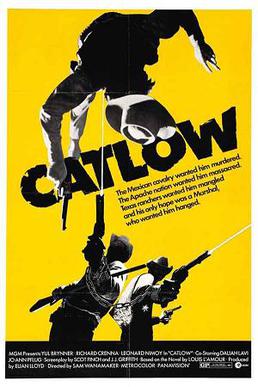
Catlow is a 1971 American Western film, based on a 1963 novel of the same name by Louis L'Amour. It stars Yul Brynner as a renegade outlaw determined to pull off a Confederate gold heist. It co-stars Richard Crenna and Leonard Nimoy. Nimoy mentioned this film in both of his autobiographies because it gave him a chance to break away from his role as Spock on Star Trek. He mentioned that the time he made the film was one of the happiest of his life, even though his part was rather brief. The film contains a lot of tongue-in-cheek and sardonic humor, especially between Brynner and Crenna's characters.

Fernando Casado Arambillet, best known as Fernando Rey, was a Spanish film, theatre, and television actor, who worked in both Europe and the United States. A suave, international actor best known for his roles in the films of surrealist director Luis Buñuel and as the drug lord Alain Charnier in The French Connection (1971) and French Connection II (1975), he appeared in more than 150 films over half a century.
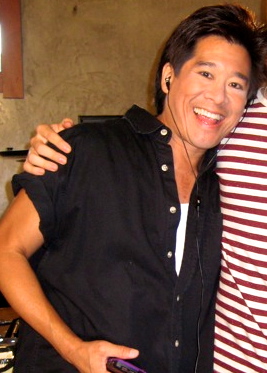
Brian Tochi is an American actor. During the late 1960s through much of the 1970s and 1980's, he was one of the most widely seen East Asian child actors working in U.S. television, appearing in various TV series and nearly a hundred advertisements. He is recognized around the world for starring in some of the most popular film franchises of all time, and best known for his characters Toshiro Takashi from the Revenge of the Nerds film franchise, Cadet Tomoko Nogata from the third and fourth films in the Police Academy series, and as the voice of Leonardo in the first three live-action Teenage Mutant Ninja Turtles films.
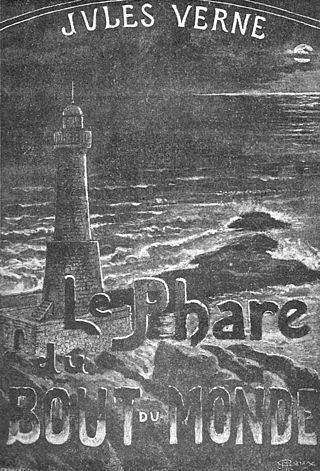
The Lighthouse at the End of the World is an adventure novel by French author Jules Verne. Verne wrote the first draft in 1901. It was first published posthumously in 1905. The plot of the novel involves piracy in the South Atlantic during the mid-19th century, with a theme of survival in extreme circumstances, and events centering on an isolated lighthouse. Verne was inspired by the real lighthouse at the Isla de los Estados, Argentina, near Tierra del Fuego and Cape Horn.

Virginia Gilmore was an American film, stage, and television actress.
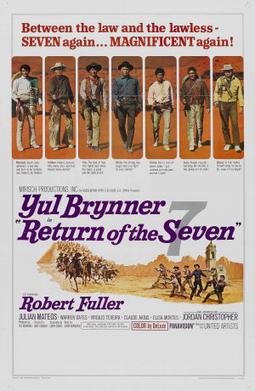
Return of the Seven, later marketed as Return of the Magnificent Seven, is a 1966 American-Spanish Western film, and the first sequel to The Magnificent Seven (1960). Yul Brynner, who reprises his role as Chris Adams, is the sole returning cast member from the original film, while Robert Fuller, Julián Mateos and Elisa Montés replace Steve McQueen, Horst Buchholz and Rosenda Monteros as Vinn Tanner, Chico and Petra respectively.
Harold Jack Bloom was an American television producer and screenwriter who scored a notable hit with his first major screenplay to the classic Anthony Mann Western The Naked Spur in 1953, earning an Oscar nomination in the process.

Solomon and Sheba is a 1959 American epic historical romance film directed by King Vidor, shot in Technirama, and distributed by United Artists. The film dramatizes events described in The Bible—the tenth chapter of First Kings and the ninth chapter of Second Chronicles.
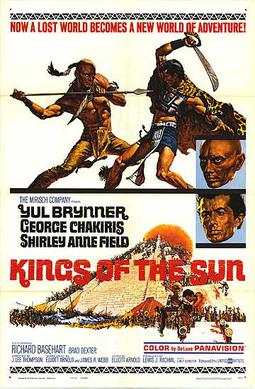
Kings of the Sun is a 1963 DeLuxe Color film directed by J. Lee Thompson for Mirisch Productions set in Mesoamerica at the time of the conquest of Chichen Itza by Hunac Ceel. Location scenes were filmed in Mazatlán and Chichen Itza. The film marks the second project Thompson completed with Yul Brynner within a year — the other being Taras Bulba.

Scalawag is a 1973 film directed by Kirk Douglas, his first of two films directed, the other being Posse. The film is a western re-telling of Treasure Island by Robert Louis Stevenson.

Bryna Productions is an American independent film and television production company established by actor Kirk Douglas in 1949. The company also produced a handful of films through its subsidiaries, Michael Productions, Joel Productions and Douglas and Lewis Productions, and outside the United States through Brynaprod. Other subsidiaries included Eric Productions, which produced stage plays, Peter Vincent Music, a music publishing company, Bryna International, a photographic service company, and Public Relations Consultants, which supervised the publicity of its early films. Douglas named the main company after his mother, Bryna Demsky, while its primary subsidiaries were named after his sons: Michael Douglas, Joel Douglas, Peter Douglas and Eric Douglas. In 1970, Bryna Productions was renamed The Bryna Company, when Douglas welcomed his children and second wife into the firm. Nevertheless, Michael, Joel and Peter, wanting to establish individual identities, went on to form their own independent film production companies.

The Son of Captain Blood is a 1962 Italian/Spanish/American international co-production film. It is the first starring role in a film for Sean Flynn, the son of Errol Flynn, who played the title character in the 1935 film Captain Blood. The film was released in Great Britain in 1963 by Warner-Pathe. Paramount Pictures released the film in the U.S. in 1964 on a double bill with the Jerry Lewis film The Patsy.



















